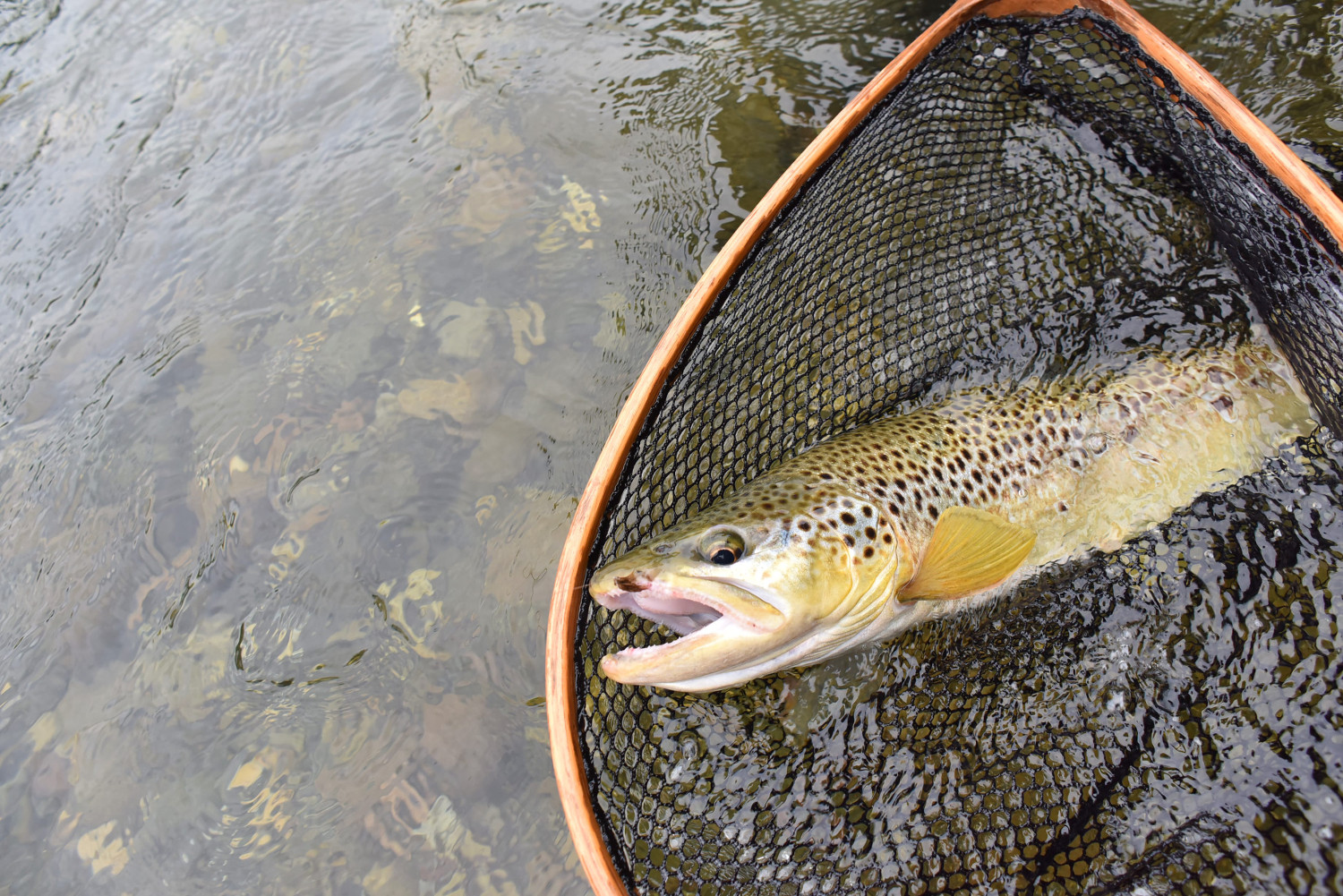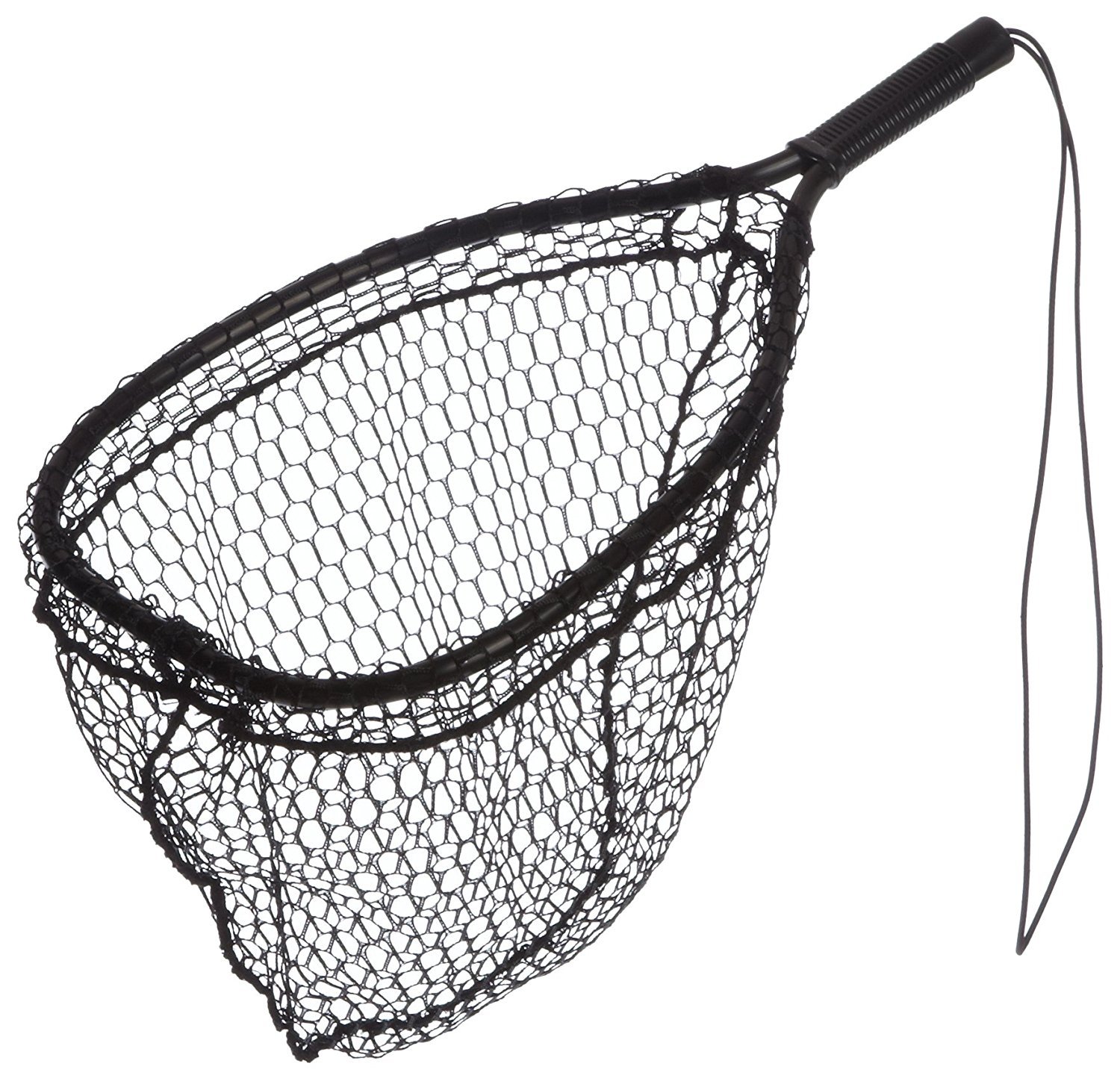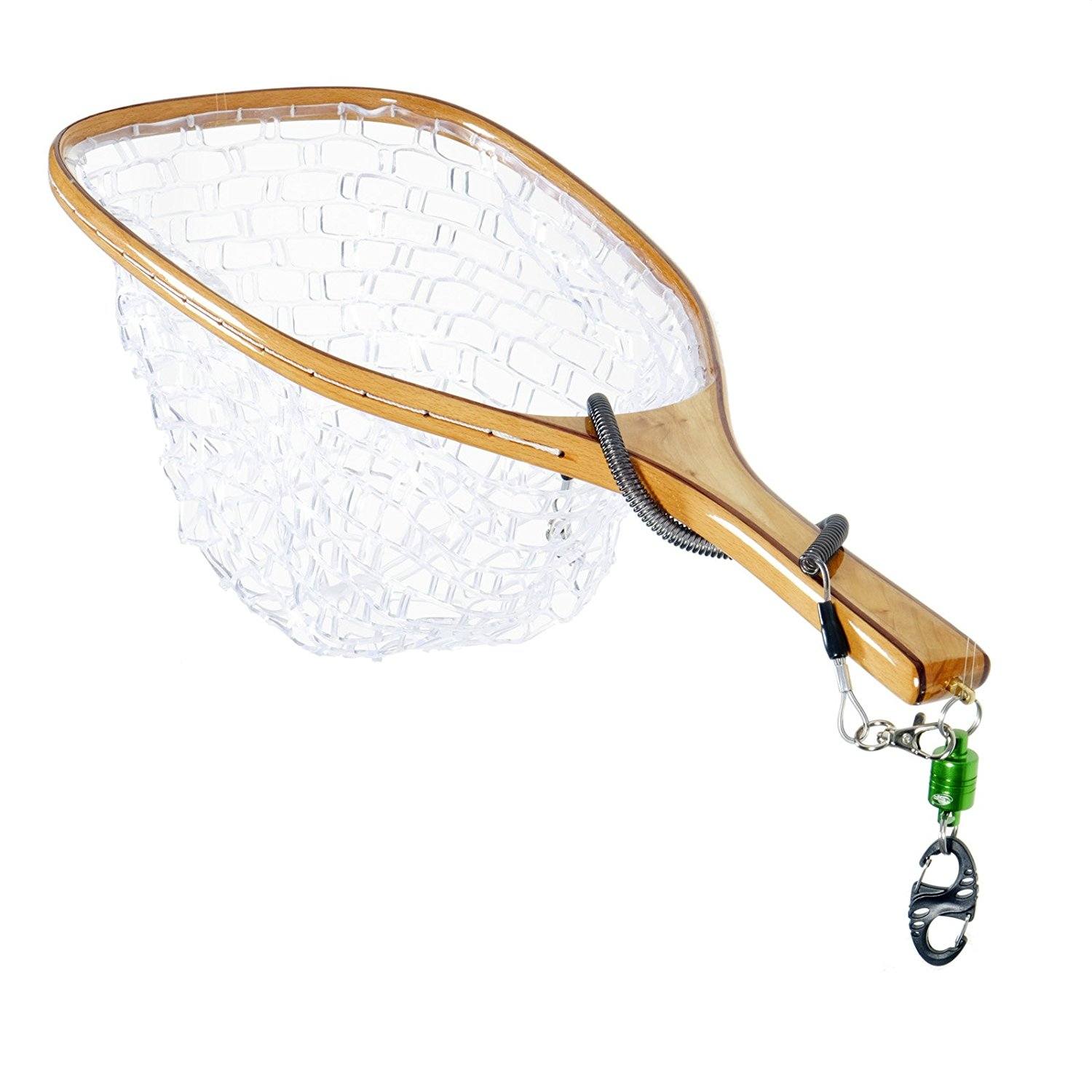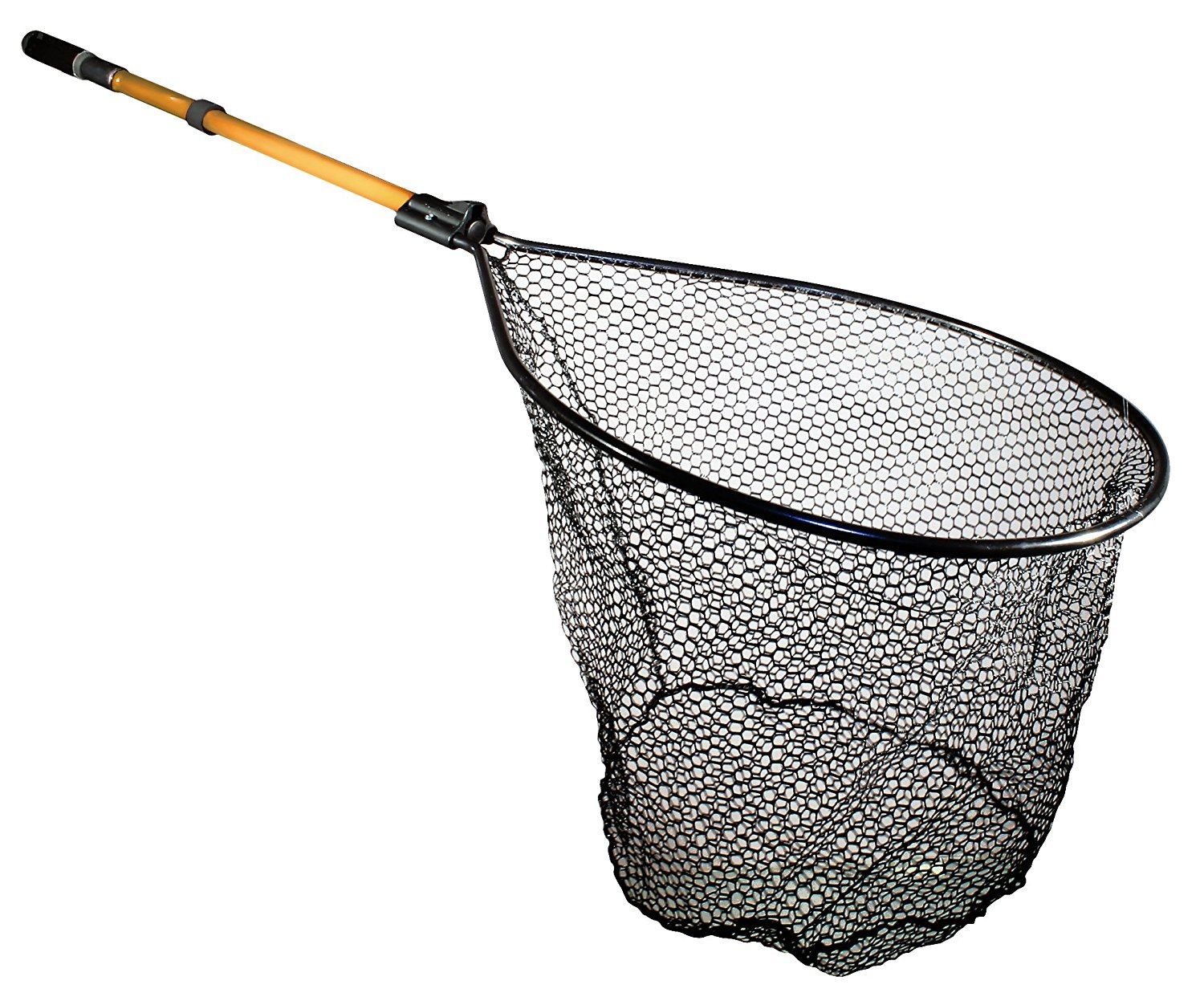Best Fish Landing Nets Reviews

Fishing nets, or more specific to this application, landing nets, are arguably one of the most underrated items for fishing. Landing nets have the ability to improve the chances of landing a trophy in certain situations, they are safer for the angler, and they definitely improve the chances of successfully releasing a catch back into its natural environment.
Recent advancements in fishing net technology have provided a wide variety of landing net designs and materials, all of which have different strengths. Additionally, convenient options that used to be expensive have now become much more affordable, such as landing nets with a telescoping handle for easy transportation and storage.
The nets themselves have also been improved. Whether it’s rubber or standard mesh material, anti-knot technology has become highly popular. Additionally, the overall design and shape of nets have been re-evaluated and now take into account supporting the entire fish’s weight for better catch and release, as well as flat linear bottoms that keep the fish from thrashing around as much.
To put it simply, there’s a lot more than meets the eye when it comes to landing nets. Whatever your reason is for wanting a landing net, it helps to have an overview of some of the differently types and designs available. Therefore, in this article, we will provide our reviews of the best landing nets for various situations. These reviews won’t be ranked in any particular order, as many have different features for different reasons, but it should help you narrow your choices to what may be best for your angling needs.
Reviews – Best Fish Landing Nets
Below are our reviews of the fish landing nets. you can find more general information on why certain features matter, and what the advantages are to owning your own landing net.
- Standard
- Fly
- Conservation
Ed Cumins Fish Saver Landing Net

Pros
- Affordable
- Simple design is easy to use
- Anodized bows
- Soft 1/2 inch nylon net is designed to avoid gilling even small fish
Cons
- Slightly limited by the size and reach
- Handle feels small if you have large hands
General Consensus
This is your conventional landing net that employs a design most anglers have used at least once. The net’s dimensions are 14 x 11 inches for the bow, 19.5 inches in overall length, and the net itself is 12 inches deep. While the small size makes it more difficult to use when landing larger fish like muskie, it’s still quite versatile, as it can be easily stored and transported, and the size is still suitable for lots of common sport fish.
The netting material is a really soft nylon with 1/2 inch spacing. It actually works quite well for the fish, as it’s pretty hard for them to become caught when thrashing around; however, if they spit the hooks out, they can become caught and/or tangled in the net.
While this is a plastic landing net, it’s constructed very well, so the durability is actually quite good. We like the handle grip, but the overall size of the handle can feel small if you have large hands. The elastic cord is also quite large, which can be good in certain situations, but if you want to use a magnetic net release, then you may be better off tinkering with the cord a bit (shortening it).
Overall, this is an excellent fishing net if you’re looking for a fairly typical design without any fancy features. It offers excellent value, as it’s one of the cheapest landing nets out there, yet it still offers good quality and durability. This could even make a great spare for days when you may be forced to cut your other net, your other net breaks, or you simply lose it.

Pros
- Good price
- Soft clear rubberized net material won’t tangle or degrade
- Comes with a nice quick-release magnetic clip with a 360 degree copper swivel at the end of the handle
- Strong and durable
Cons
- Slightly heavier
- Smaller trout may be able to squeeze through the larger bottom holes
General Consensus
This is a really well-made fly fishing net that comes with everything you need in one package. It comes in at a good price point, making it an affordable option for most fly fishermen. The handle is 6.7 inches long, the net ring has a length of 17 inches, and the net itself is about 8.5 inches deep.
The handle and net ring are made of bamboo, which is known to be a very strong material, and is subsequently laminated with polyurethane, which will add to the durability. The net material is a rubber material that we would consider soft, but still a bit more stiff than your typical nylon mesh on a standard landing net. The stiffness isn’t an issue, but if you’re worried about this, you can also try to soak the net in hot water for a while to see if it loosens up.
This fly fishing net comes with a 360 degree copper swivel as well as a quick-release magnetic clip, so it’s a nice package deal. Some anglers have found the swivel to be a little weak, as they have dropped or lost their net without noticing, but these instances are few and far in between. We find the benefits here outweigh the risk.
Overall, this is an excellent fly fishing net that is well constructed to be strong and durable, and just as importantly, highly functional. It conveniently comes with a quick-release magnetic clip, and the net material is a soft rubber, which is pretty cool. The net is a nice size for storage and transportation, but if you’re casting for really large fish, you may need a net deeper than 8.5 inches. If the size is suitable for you, than we would consider this to be one of the top options available.
Frabill Conservation Series Landing Net

Pros
- 3/8 inches tangle-free knotless mesh netting.
- 16 inch deep flat bottom net basket
- CAM-LOK reinforced handle with 1 inch diameter
- Telescoping handle
- Reliable brand
Cons
- Expensive
- Handle only goes half way into net area for storage
General Consensus
Simply put, this is an awesome fishing net. It combines two of our favorite features: a telescoping handle and a deep net designed with the fish’s well-being in mind. The hoop is 20 x 23 inches, and the telescoping handle extends from 24 inches to 48 inches. The net itself is 16 inches deep with 3/8 inch spacing.
This net material is great because it’s tangle-free and knotless. Not only will this benefit the fish’s survival (assuming catch and release), but it will also help prevent hooks from being cut, limiting your odds of having to cut the net. We like the flat bottom design for when the fish are thrashing about, and it makes the release easier as well, even if you’re releasing the fish with your hands (net is easier to reach into).
The telescoping handle is also a great touch, especially considering the hoop is fairly substantial in size and the net is quite deep. This will make storage and transportation easier, and more importantly, it increases the versatility of your landing net.
Overall, this is an extremely well-like and well-reviewed landing net by many anglers. It employs lots of features into one design, and in addition to being a conservation line of landing net, it is also highly versatile, so can be used when fishing in many different settings. The only reported downsides are that some anglers find it a little expensive for what it is, but that being said, everyone is thoroughly pleased with the quality. The handle only folds about half-way into the net area for storage, so it seems like it isn’t using its space as efficiently as it could, but this is a very minor issue that we wouldn’t look too much into. If you have room in the budget, you’ll be hard-pressed to find a better quality landing net.
What to Look for in a Landing Net
Most anglers take a while to find out what they desire in a landing net. This is because it depends on where and what you’re fishing, how you’re fishing, and you previous experience with fishing nets. However, if you’re a beginner angler and want some advice regarding where to start when looking for a good landing net, here are a few brief pointers that could help you get started.
Landing Net Design
The Ed Cumins landing net that we reviewed above is what we would consider a standard design. It’s a simple design that suits many different situations, but doesn’t offer the bells and whistles that many anglers have now come to appreciate. Standard landing nets are highly popular, but are usually more prone to tangling and knotting, mainly because they are cheaper options.
- Fly fishing landing nets – aren’t too much different from standard fishing nets. They may come with a telescoping handle (we’ll talk about this shortly), but not usually, as a telescoping handle may increase weight and size, which isn’t necessary when you’re wading in a river. However, they will sometimes come with a quick-release magnetic clip, which is a great option to have in order to keep your net attached to your body, while still being able to easily and quickly grab it for use when landing a beautiful trophy!
- Telescoping landing nets – differ in the design of the handle. The telescoping design allows you to extend and retract the handle as necessary, which is a highly convenient feature. If this is something you’re interested in, we would suggest going for a landing net that is known to be a little more reliable or durable. Incorporating sliding parts can increase chances of damage, and if the net isn’t designed well, the handle may be a little flimsy at full length. There are lots of telescoping landing nets available, so there are lots of suitable options. The Frabill Conservation Series Landing Net that we reviewed above has a telescoping handle, and is an extremely well-reviewed landing net overall.
- Conservation landing nets – are usually different from standard landing nets by incorporating either a different net material, different net shape, or a combination of those two. For example, a flat-bottom net is often utilized so that the fish doesn’t become tangled in the net when it initially thrashes around. They will often be constructed with a softer material, and the holes will be spaced such that there is a much lower chance of catching on their gills, and lures are usually less likely to hook up in the net as well. The ultimate goal of a conservation landing net is to improve the fish’s chances of survival upon being released, thereby facilitating sustainable fishing.
Check out the video below, which offers a great tutorial on how to catch and release trout in a safe and sustainable manner. Notice they opt for a rubber mesh in this case in order to scrape less of the trout’s natural slime layer off of its body, as opposed to a conventional woven mesh.
Landing Net Basket
The best fish landing net basket is the net part itself. There are a few things to consider here. We already touched on net material, but to clarify, net material can actually be different between different landing nets. For example, the standard is usually a conventional nylon material, while others may be made of rubber, or even a rubber coated wire material.
The design of a landing net can also vary. Some have a flat bottom to help with releasing a fish in a healthy manner, while others taper at the bottom to try and keep the fish in one spot. The spacing of the holes/net material is also important. You want to make sure that the holes are small enough that you won’t let any fish through (at least the ones you’re fishing for).
The size of the net is also a very important consideration. First, you want to make sure the hoop is big enough to actually allow a fish to enter the net when you scoop it. Secondly, you want to make sure it is deep enough, but not too deep. If people struggle with this, it’s usually because the net isn’t big enough, rather than too deep, but both are possible. Whenever you’re shopping for a landing net, the dimensions of the hoop and depth of the net should be listed in inches.
Other Considerations
Any other considerations for a best fish landing net are usually based in personal preference developed through experience. Some people who tend to lose fishing nets, or at least fish from a boat most often, tend to like landing nets that float. This way, if the net falls out of the boat, they don’t lose it forever! Another feature to look into is net color. Some like a clear or black mesh to help try and hide the net material as well as possible when scooping a fish, but we don’t think this should be a top level consideration, although it can make a difference for some.
Conclusion
At the end of the day, as long as you have something that is a good size for the fish you’re catching, it’s relatively strong and durable, and you can get it at a good price, then it’s tough to go wrong when buying a landing net. However, the more research you do, the better. Therefore, we hope this article has helped narrow your selection a little bit, or at least provided you with some ideas for what to look for in a good landing net. Hopefully you’ll be able to get out and test your new best fish landing net soon!
